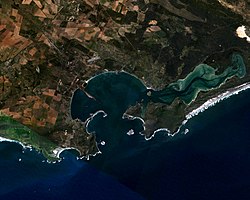Battle of Saldanha Bay (1781)
| Battle of Saldanha Bay | |||||||
|---|---|---|---|---|---|---|---|
| Part of the Fourth Anglo-Dutch War | |||||||
 |
|||||||
|
|||||||
| Belligerents | |||||||
|
|
|
||||||
| Commanders and leaders | |||||||
| George Johnstone | Gerrit Harmeyer | ||||||
| Strength | |||||||
| 12 warships + 7 armed transports | 8 vessels of the Dutch East India Company | ||||||
| Casualties and losses | |||||||
| none | light 5 ships captured 1 ship destroyed |
||||||
The Battle of Saldanha Bay was a naval action that occurred off the Dutch Cape Colony on 21 July 1781 during the Fourth Anglo-Dutch War. A squadron of Royal Navy warships under the command of commodore George Johnstone captured five Dutch East India Company ships; her own crew destroyed a sixth. Casualties on the Dutch side were minimal if any, and there were no British casualties.
Note: inconsistency in the spelling of the Dutch vessels' or their masters' names below reflects inconsistency among the sources.
Johnstone had been directed to capture the Dutch settlement at the Cape of Good Hope. However, France had learned of his mission, and the French admiral Bailli de Suffren frustrated the mission. Suffren was en route to the Indian Ocean, but the French marine ministry had warned him so he sought to reach the Cape before Johnstone. After an indecisive chance encounter (Battle of Porto Praya), between the two fleets in the Cape Verde Islands on 16 April 1781, Suffren sailed for the Cape while Johnstone remained at Porto Praya for repairs. As a result, Johnstone found the Dutch settlement well defended when he arrived there in July and decided against an attack.
The Dutch had, as a precaution, directed their westbound merchant fleet, laden with goods, to anchor in Saldanha Bay where they would be concealed from the British fleet. They were under orders to ground and burn their ships if the British were to appear; however they were not vigilant in their watches.
One of Johnstone's frigates, flying French colours, intercepted a Dutch merchantmen that had left the bay several days earlier, heading east. The Dutch vessel was the Heldwoltenmade, Vrolyk, master, which had sailed from Saldanha Bay on 28 June carrying stores and £40,000 in bullion to Ceylon. She struck to Active on 1 July. From Heldwoltenmade Johnstone learned of the whereabouts of the Dutch fleet.
...
Wikipedia
